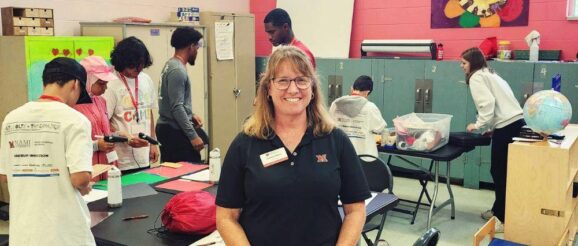NumberUp Innovation STEM camp introduces kids to manufacturing

Miami University engineering students and the Cincinnati Recreation Commission ran the multiweek NumberUp workshop as part of the NBT summer camp series.
An introduction to manufacturing has to start somewhere. And for kids in Cincinnati, Joanna Hohn hopes her NumberUp Innovation STEM camp provides that primer.
“We never know who all we’re impacting,” said Hohn, assistant director of college of engineering and computing outreach programs K-12 at Miami University in Oxford, Ohio. “If it’s just the student in the camp; if it’s an older sibling who hears about it; if it’s other family or friends.”
This past July, Hohn, with the help of some Miami University engineering students and the Cincinnati Recreation Commission, ran the multiweek NumberUp workshop as part of the Nuts, Bolts & Thingamajigs (NBT) summer camp series. NBT is the foundation of the Fabricators and Manufacturers Association.
The camp offered the middle school-aged attendees an overview of all things manufacturing and how STEM not only plays a major role in the industry, but also can lead to future career opportunities.
“Most kids like working with their hands. So, this is just opening their eyes,” said Hohn, who’s in her second year running the NumberUp camp. “I think most of them don’t have any idea what these types of jobs are. They’re not seeing or hearing about it in school. Their teachers aren’t in those fields. This just gives them that exposure and the chance to explore.”
In a classroom at the Corryville Recreation Center in urban Cincinnati, NumberUp campers were introduced to a wide variety of STEM-related technologies and processes, from prototyping to research and development to designing with software to running small-scale machines.
They learned Autodesk Tinkercad to design objects to 3D print and used Cricut cutting machines to cut different materials at certain depths.
And while students were mostly working with safe materials like cardboard, construction paper, and cardstock, Hohn believes that could translate to them problem-solving with sheet metal down the road.
“I think it’s important that we expose them to different types of engineering and allow them to problem-solve, which is a huge piece and something we talk about all the time,” Hohn said.
Ultimately, the main approach for the in-class exercises is that problems exist to be solved.
NumberUp Innovation STEM camp attendees created prototype workflows.
“There are no grades associated with this,” Hohn added. “If you try something and you fail, that’s OK. You just talk about it, and you learn.”
But before the campers even started product design exercises, they visited a few Cincinnati-area manufacturing facilities, including Procter & Gamble Co., Energizer/Armor All, medical equipment maker Ethicon, and research and product development firm Kinetic Vision.
“We’re showing them STEM companies in their community where there are jobs,” said Hohn.
The students also got an up-close and personal view of manufacturing technologies in action. At the Procter & Gamble facility, they got a crash course on how the company uses automation, robotics, and additive manufacturing in all aspects of their engineering and logistical processes.
Hohn feels the facility tours were key to reinforcing what they were learning about prototyping in the classroom.
“How can we create a product if they haven’t even seen what that’s like? It helps that they’ve been to these places, and they’ve seen all of what goes on,” said Hohn. “What we’re doing here wouldn’t be the same without those STEM field trips. They can see how products evolve and change over time.”
Next year, Hohn hopes that she can use grant money to purchase some injection molding equipment for NumberUp campers to use on the Miami University campus.
“We’ve seen injection molding on our different field trips,” Hohn said. “Now we want them to be able to use it themselves.”
She also hopes to continue to expand efforts to reach all demographics in Cincinnati’s diverse urban population. And, with that, continue to hire camp staff from Miami University that reflect that diversity.
“We need to diversify the pipeline coming into all of these jobs,” Hohn said of the all the manufacturing sectors. “We have a very diverse group of students here at all of our urban sites. It’s important to connect with them. That’s been really beneficial.”
NumberUp Innovation STEM camp attendees went on a field trip to visit several Cincinnati-area manufacturing and engineering facilities, including product development firm Kinetic Vision. Joanna Hohn
